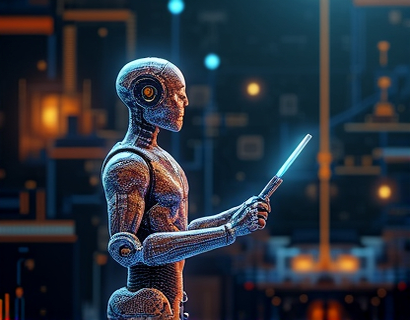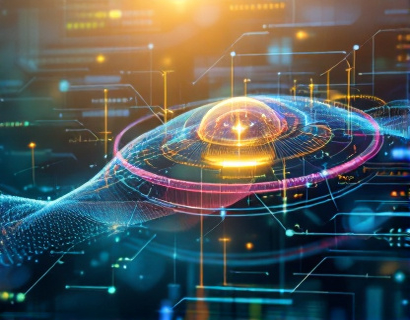Powering the Future of Digital App Ecosystems: The Synergy of Crypto and AI
The integration of cryptocurrency and artificial intelligence is ushering in a new era of digital innovation, transforming the way we interact with apps and services online. This fusion of technologies is not only enhancing security and efficiency but also creating more intuitive and personalized user experiences. As we delve into this transformative landscape, it's essential to understand the key components and potential applications that are redefining the digital world.
Understanding Cryptocurrency and Its Role in Digital Ecosystems
Cryptocurrency, built on blockchain technology, offers a decentralized and secure method for transactions. Unlike traditional currencies, cryptocurrencies like Bitcoin and Ethereum operate on a peer-to-peer network, eliminating the need for intermediaries such as banks. This decentralization ensures transparency and reduces the risk of fraud, making it an attractive solution for digital app ecosystems.
The use of cryptocurrencies in digital platforms provides several advantages. Firstly, it enables seamless and instant transactions across borders without the high fees associated with traditional banking systems. Secondly, the immutable nature of blockchain ensures that transaction records are tamper-proof, enhancing trust and reliability. Lastly, cryptocurrencies can be integrated into apps to offer users more control over their data and financial transactions, fostering a more user-centric approach.
Artificial Intelligence: The Brain Behind the Scene
Artificial intelligence, particularly machine learning and deep learning, plays a crucial role in enhancing the functionality and user experience of digital apps. AI algorithms can analyze vast amounts of data to identify patterns, predict user behavior, and optimize app performance. This capability is invaluable in creating personalized experiences, where apps can adapt to individual user preferences and needs.
One of the most significant applications of AI in digital ecosystems is in natural language processing (NLP). NLP enables apps to understand and respond to user queries in a human-like manner, improving customer support and interaction. Chatbots powered by AI can provide 24/7 assistance, handle multiple queries simultaneously, and offer solutions based on real-time data analysis.
Blockchain and AI: A Powerful Combination
The convergence of blockchain and AI creates a synergistic effect that amplifies the benefits of both technologies. Blockchain provides a secure and transparent platform for AI algorithms to operate on, ensuring data integrity and privacy. Conversely, AI can enhance the efficiency and scalability of blockchain networks by optimizing consensus mechanisms and improving transaction processing speeds.
For instance, AI can be used to develop more efficient consensus algorithms, reducing the computational power required for validating transactions. This not only lowers the energy consumption of blockchain networks but also makes them more sustainable. Additionally, AI-driven analytics can help identify and mitigate potential security threats, further strengthening the security of digital app ecosystems.
Enhancing Security Through Crypto and AI
Security is a paramount concern in the digital age, and the combination of cryptocurrency and AI offers robust solutions to protect user data and transactions. Blockchain's inherent security features, such as cryptographic hashing and decentralized consensus, provide a strong foundation. AI complements this by continuously monitoring for anomalies and potential threats, enabling real-time detection and response.
One innovative approach is the use of AI for identity verification and access control. By leveraging biometric data and behavioral patterns, AI can authenticate users with high accuracy, reducing the risk of unauthorized access. Furthermore, AI can help in detecting and preventing fraudulent activities by analyzing transaction patterns and identifying suspicious behavior.
Personalization and User Experience
Personalization is key to retaining users and enhancing their overall experience. AI algorithms can analyze user data to create tailored recommendations, content, and interfaces. In the context of digital app ecosystems, this means that apps can offer a more intuitive and user-friendly experience, adapting to individual preferences and behaviors.
For example, a music streaming app can use AI to curate playlists based on a user's listening history and preferences. Similarly, an e-commerce platform can recommend products that align with a user's past purchases and browsing behavior. These personalized experiences not only increase user satisfaction but also drive engagement and retention.
Optimizing App Performance with AI
AI can significantly improve the performance of digital apps by optimizing various aspects of their operation. One such area is resource management, where AI algorithms can dynamically allocate computational resources based on real-time demand. This ensures that apps run smoothly even during peak usage times, providing a seamless user experience.
Another critical aspect is predictive maintenance. AI can predict potential system failures or performance bottlenecks by analyzing historical data and current metrics. This proactive approach allows developers to address issues before they impact users, ensuring high availability and reliability of the app.
Decentralized Applications (DApps) and Smart Contracts
Decentralized applications (DApps) are a prime example of how blockchain and AI can transform digital ecosystems. DApps run on a blockchain network and are governed by smart contracts, which are self-executing contracts with the terms directly written into code. This combination ensures transparency, security, and automation.
AI can enhance DApps by providing intelligent decision-making capabilities. For instance, AI-driven oracles can feed real-time data into smart contracts, enabling them to make informed decisions based on current conditions. This is particularly useful in decentralized finance (DeFi) platforms, where AI can optimize trading strategies and risk management.
Challenges and Considerations
While the integration of cryptocurrency and AI offers numerous benefits, it also presents several challenges. One of the primary concerns is regulatory compliance. The decentralized nature of cryptocurrencies and the evolving landscape of AI regulations require careful navigation to ensure compliance with legal standards.
Another challenge is the technical complexity involved in integrating these technologies. Developers need a deep understanding of both blockchain and AI to create robust and efficient solutions. Additionally, there is a need for standardization to facilitate interoperability between different platforms and systems.
Future Prospects and Innovations
The future of digital app ecosystems is bright, with ongoing innovations promising even more advanced solutions. One area of focus is the development of more sophisticated AI models that can operate on blockchain networks with minimal latency. This could lead to real-time AI-driven decision-making within DApps, further enhancing user experiences.
Another exciting development is the integration of quantum computing with blockchain and AI. Quantum computing has the potential to solve complex problems that are currently infeasible for classical computers, potentially revolutionizing data processing and security in digital ecosystems.
Moreover, the rise of Web 3.0, a decentralized internet powered by blockchain, will play a crucial role in shaping the future. AI will be integral to this new web, enabling more intelligent, secure, and user-centric applications.
Conclusion
The fusion of cryptocurrency and AI is poised to redefine the digital landscape, offering unprecedented opportunities for innovation and growth. By leveraging the strengths of both technologies, we can create more secure, efficient, and personalized digital app ecosystems. As these advancements continue to evolve, it's essential for tech enthusiasts and professionals to stay informed and embrace the transformative potential of this synergy.











































